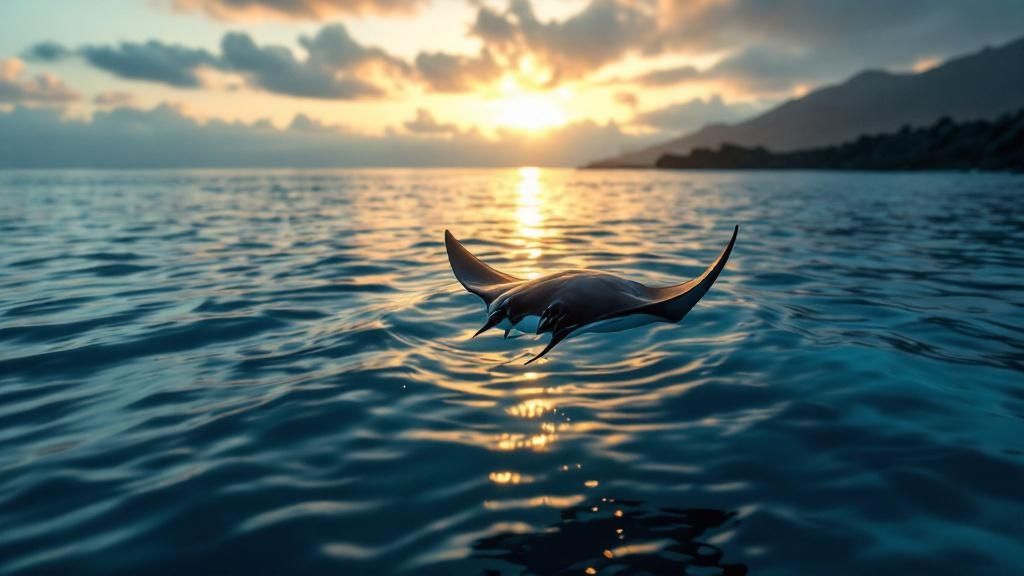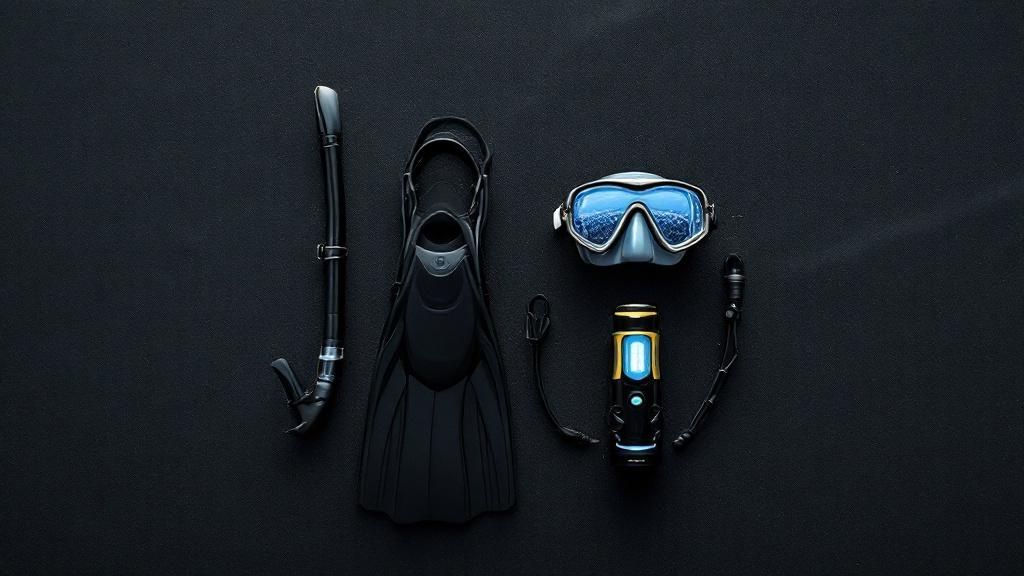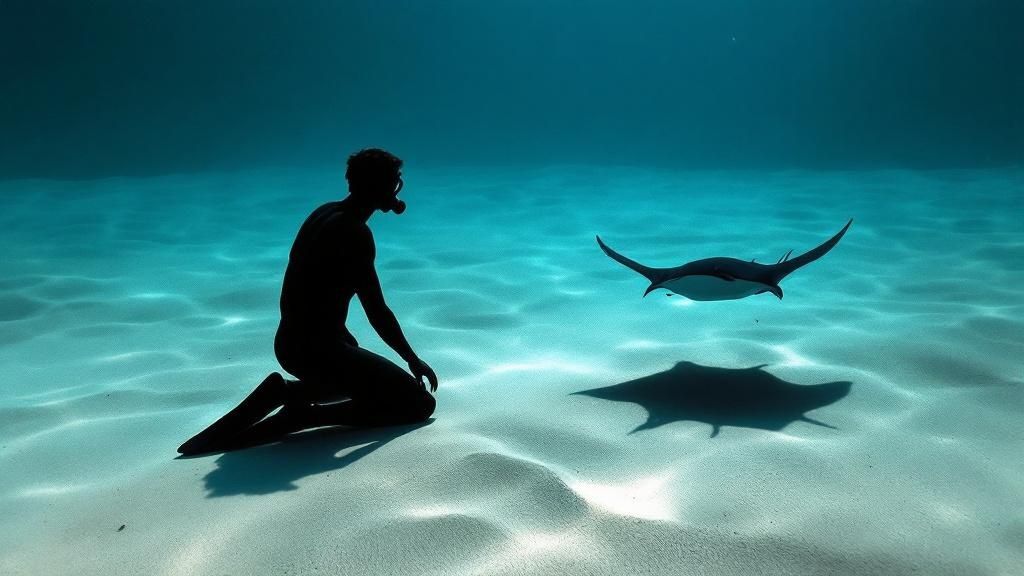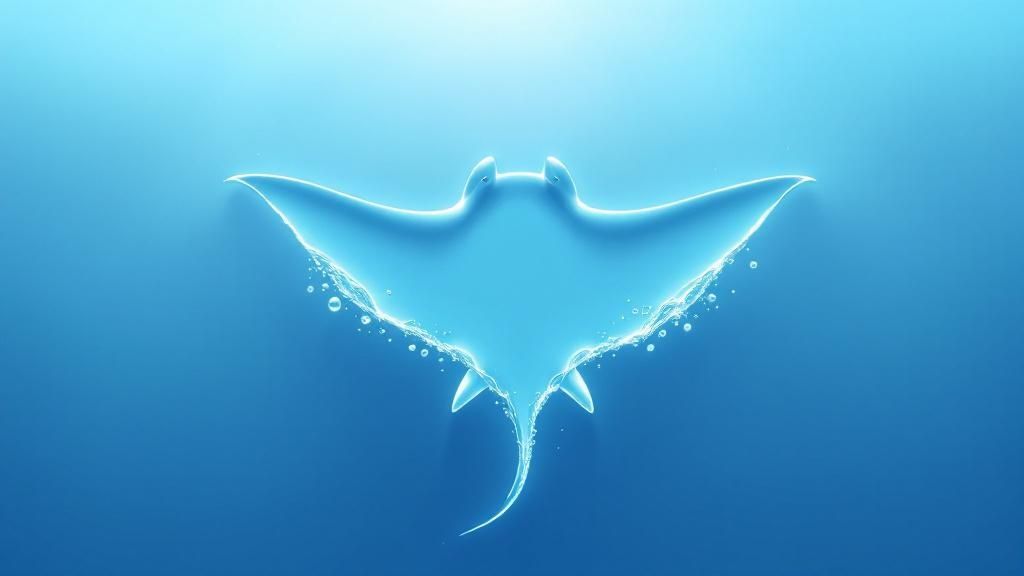When you think of the world's truly unforgettable wildlife encounters, the manta ray dive in Kona sits right at the top of the list. It’s more than just a dive; it’s an underwater ballet, and you’re guaranteed a front-row seat. Best of all, this incredible experience is open to certified scuba divers and snorkelers alike.
What Makes the Kona Manta Ray Dive a Must-Do
Picture a carefully set stage. Tour operators bring out powerful underwater lights, which act like a massive bug zapper for plankton. This huge concentration of the mantas' favorite food creates a natural buffet that draws them in from all around. It's this clever, non-invasive approach that has given the Kona dive its reputation for being so incredibly reliable.
The Kona Coast has become the world's top spot for this activity, welcoming around 80,000 people every year. The reason it's so popular is simple: an astonishingly high success rate. Manta rays show up on 80-90% of tours throughout the year, making an encounter almost a sure thing. You can dive deeper into the numbers and conservation efforts over at Manta Ray Advocates.
To give you a quick overview, here are the essential details for planning your trip.
Kona Manta Ray Dive At a Glance
| Attribute | Details |
|---|---|
| Location | Kona Coast, Big Island, Hawaii |
| Activity | Night dive or snorkel with Manta Rays |
| Best Time to Go | Year-round |
| Sighting Success Rate | 80-90% on average |
| Typical Depth (Divers) | 30-40 feet (9-12 meters) |
| Typical Depth (Snorkelers) | Surface level |
| Required Certification | Open Water for divers; none for snorkelers |
This table covers the basics, but the real magic is in the experience itself.
A Predictable Underwater Show
Unlike so many wildlife tours that rely on pure luck, the Kona manta dive is built on a solid understanding of animal behavior. It’s important to know that the mantas aren't being baited or fed anything unnatural. The guides are simply creating the perfect conditions for the mantas to do what they do naturally—feed.
The real magic is how close the mantas get. They gracefully perform barrel rolls just inches away, swooping through the light beams to filter plankton from the water. It’s a completely passive, observation-only experience that feels both thrilling and serene.
Who Can Participate?
One of the greatest things about this adventure is that almost anyone can do it. You absolutely do not need to be an expert diver to see the show.
- Scuba Divers: If you're certified, you'll get to settle on the sandy ocean floor, usually around 35 feet deep. From there, you'll look up as the gentle giants soar directly overhead, putting you right in the middle of the action.
- Snorkelers: Not a diver? No problem. You'll have an equally breathtaking view from the surface. Snorkelers hold onto a custom-made floating raft that has bright lights shining down into the water, which draws the mantas right up to you.
This setup means that everyone—from families and couples to solo travelers with different levels of water confidence—can share in the same amazing spectacle.
Ready to plan your trip? Our guide to the manta ray night dive in Kailua-Kona has all the booking details and tips you'll need.
Choosing Your Ideal Manta Ray Dive Site

The first real decision you'll make when planning your manta ray adventure is picking the right spot. While you truly can’t go wrong with either of Kona’s world-famous sites, they each have a unique vibe. Knowing the difference between them is key to matching the experience to your comfort level and what you hope to see.
Kona has two primary locations for the manta show: Manta Village and Manta Heaven. I like to think of them as two fantastic theaters showing the same incredible performance, just with different stage setups. Both offer mind-blowing views, but one might feel like a better fit depending on your personal style.
Manta Village: The Accessible Front-Row Seat
Located down in Keauhou Bay, Manta Village is often called the "original" manta site, and for good reason. Its main appeal is just how accessible it is, which opens the door for almost everyone to join in.
- Shallow and Calm: The whole experience happens over a sandy bottom in relatively shallow water, usually around 25 to 35 feet. Because it's tucked into a protected bay, the conditions are typically very calm.
- Perfect for Beginners: This predictability makes it an amazing choice for first-time night divers, snorkelers, and families who might feel a bit hesitant about being in the open ocean after dark.
- High Success Rate: Manta Village has an incredibly consistent track record for sightings, with a success rate that often tops 90%.
Its gentle, controlled environment removes a lot of the potential stress, letting you focus completely on the incredible ballet of the mantas. It's a fantastic introduction.
Manta Heaven: The Dynamic Underwater Stage
If you head a bit further north, closer to the airport, you'll find Manta Heaven. This site offers a slightly more dynamic and, for some, more thrilling encounter. It's often the preferred spot for divers who have a bit more experience under their weight belts.
It is globally renowned for its unique underwater experiences, particularly at these two main locations. Manta Village is especially suited for beginner divers due to its shallow sandy bottom and calm waters. In contrast, Manta Heaven offers a deeper and slightly more current-active environment favored by experienced divers seeking close-up manta encounters. Learn more about what makes each Kona dive site special.
This location can feel a bit more "wild." You might encounter stronger currents, which can make the mantas put on an even more energetic show as they swoop and barrel-roll through the light beams. This creates absolutely spectacular moments for photographers and videographers.
While both spots are genuinely breathtaking, picking the right one helps set the stage for your perfect adventure. You can find even more details to get you ready in our complete manta dive kona guide. Whether you opt for the serene theater of Manta Village or the high-energy spectacle of Manta Heaven, you're in for a night you’ll never forget.
How to Prepare for Your Night Dive
A truly great manta ray dive in Kona starts long before you even see the ocean. Getting your logistics sorted out ahead of time is the secret to a smooth, stress-free, and absolutely magical experience. It all begins with picking the right crew to lead your adventure.
Your first move should be to find operators who are Manta-Safe Certified. This isn't just a fancy sticker for their boat; it's a promise. These companies follow a strict code of conduct designed to protect the mantas and their delicate environment. They put the animals' welfare first, which means every interaction is passive and respectful. The result? A much better, more natural encounter for you.
Once you’ve booked your trip, it’s time to think about what to pack. The trick is to bring only what you truly need and leave everything else behind.
What to Bring on the Boat
Your tour operator will have all the dive and snorkel gear covered, but a few personal items will make a world of difference in your comfort. Think of it as your personal comfort kit for the trip out and, more importantly, the ride back.
- Warm Clothes: Don't skip this. Even after a balmy Hawaiian day, the wind on the boat ride back to the harbor can feel surprisingly cold once you're wet. A hoodie or a simple windbreaker will feel like a lifesaver.
- Towel: An obvious one, but essential for drying off. A compact, quick-dry travel towel is perfect for saving space in your bag.
- Reef-Safe Sunscreen: For the sunset tours, you’ll want to apply this before you go. Many common sunscreens contain chemicals that are incredibly damaging to our coral reefs. Look for a mineral-based, reef-safe formula to be a responsible visitor.
- Reusable Water Bottle: Staying hydrated is key. While most boats have water, bringing your own bottle is a simple way to help cut down on plastic waste.
- Seasickness Medication: If you even think you might get seasick, take your preferred medication before you board the boat. The waters are usually pretty calm, but it's always better to be safe than sorry.
Mental and Physical Readiness
Getting ready for a manta ray dive kona is about more than just what's in your bag—it's also about getting your head in the game. For a lot of people, this is their very first night dive. It’s totally normal to feel a cocktail of pure excitement and a few butterflies.
The most important thing you can do is trust your guide. These are seasoned pros who live and breathe this experience every single night. Their top priority is your safety and comfort, so pay close attention during the briefing and follow their lead.
Remember, you are a passive observer. The beauty of this encounter is letting the mantas lead the interaction. By staying calm and still, you become part of the underwater scenery, allowing the gentle giants to approach you on their own terms.
If you start feeling a little anxious, just focus on your breathing. Taking slow, deep breaths can work wonders for calming your nerves. The dive itself is very controlled and static; you'll mostly be kneeling or sitting on the sandy bottom, looking up at the incredible show above.
Just embrace the darkness and trust the process. It will allow you to relax and fully soak in one of the most awe-inspiring wildlife spectacles on the entire planet.
What to Expect During Your Manta Encounter

As your boat motors out from the coast, the sun starts to dip below the horizon, setting the sky ablaze with color. This is more than just a boat ride; it’s a transition. The energy on board is pure anticipation. Once you arrive at the dive site, the deep blue of twilight gives way to the inky black of the ocean at night, and you know the main event is about to begin.
Slipping into the warm, dark water is a feeling unlike any other. Suddenly, your world is defined by the narrow beam of your dive light, creating an incredibly personal and focused experience. You'll follow your guide down to the sandy bottom, usually at a comfortable depth of about 30 to 40 feet. Once there, your group will arrange itself into a large semi-circle on the ocean floor, finding a spot to settle in for the show.
The Campfire and the First Arrival
Your guide will place a powerful light in the center of the group, pointing its beam straight up toward the surface. We call this the "campfire." It's a brilliantly simple concept: the intense light acts as a magnet for microscopic plankton, which are the manta rays' favorite meal. To get the full rundown on the science behind this, you can read our guide on what a manta ray night dive involves.
Then, you wait. The darkness is quiet, and the excitement in the water is almost tangible. All at once, a massive, graceful shadow emerges from the void, gliding effortlessly into the light. It's a heart-stopping moment. Soon, another follows, and then another, as more mantas arrive for the all-you-can-eat plankton buffet.
The single most important rule for this encounter is to be a passive observer. Your job is to stay on the bottom, remain as still as you can, and let the mantas choreograph the entire interaction. Never, ever reach out to touch them.
Following this one rule is the key to the magic. By making yourself part of the scenery, you signal to these gentle giants that you're not a threat. In return, they'll feel comfortable enough to swoop within inches of your head, performing their incredible feeding acrobatics.
The Underwater Ballet
What you're about to witness is the mantas' famous feeding behavior, up close and personal. You'll see them swoop and glide through the light beams, their cavernous mouths wide open to filter the plankton from the water. The signature move everyone hopes to see is the barrel roll—a complete underwater somersault that allows them to get every last bit of food. It's truly an underwater ballet, performed on a scale that is simply breathtaking.
This experience is deeply moving and forges a connection with the ocean that's hard to describe. It's a reminder of the incredible wildlife just below the surface. Of course, amazing animal encounters aren't limited to manta rays. Globally, many opportunities exist to see spectacular creatures, like the unforgettable thrill of seeing massive humpbacks on whale watching experiences.
All too soon, your guide will give the signal that it's time to head up. You'll slowly ascend, leaving the underwater ballroom and its dancers behind. The boat ride back to shore is usually a mix of stunned silence and excited chatter as everyone tries to process the incredible spectacle they just witnessed.
The Science and Conservation Behind the Magic

The incredible consistency of the manta ray dive in Kona isn't just a happy accident. It’s the result of a fantastic partnership between tourism, science, and the mantas themselves. This world-famous encounter is much more than a spectacular show; it's a living, breathing laboratory that helps protect these gentle giants, turning every visitor into a citizen scientist.
The whole thing works because we’ve learned to understand and respect the mantas as individuals. Think of it like a human fingerprint—each reef manta ray (Mobula alfredi) has a totally unique pattern of black spots on its white belly. This natural "barcode" is the key, allowing researchers and dive guides to identify and track specific mantas over their entire lives.
So when your guide casually points out a regular visitor by name, like "Lefty" or "Big Bertha," they aren't just giving them cute nicknames. These are documented individuals in a massive database, some of whom have been showing up to dinner for decades!
From Identification to Conservation
This ability to tell one manta from another is the bedrock of all conservation work in Kona. Once you know who's who, you can start to piece together the puzzle of their lives, gathering data that would be almost impossible to get otherwise.
- Population Health: By tracking individuals, researchers can get a solid estimate of the local manta population's size and overall health.
- Behavioral Insights: Long-term observation sheds light on their social lives, feeding routines, and even their reproductive cycles.
- Protecting Their Homes: Knowing which mantas hang out at which sites helps advocates protect these critical habitats from threats like development or overuse.
This deep well of knowledge comes from years of dedicated fieldwork. For example, a massive effort from 2009 to 2014 had research teams diving almost every single night at sites like Manta Village. They painstakingly photographed and documented individual belly patterns, creating a foundational dataset that is still crucial for manta research today.
This teamwork between dive operators and research groups is a perfect example of ecotourism done right. The very lights that draw in the plankton for the mantas also create the ideal, non-invasive setup for scientists to snap those all-important photo-identifications.
Your Role in the Story
When you join a manta ray dive in Kona with a responsible, Manta-Safe certified operator, you’re not just a spectator—you're an active participant in this beautiful cycle. A portion of what you pay often goes directly to funding this vital research and conservation.
Your presence helps prove that a living manta ray is far more valuable to the local community and economy than a dead one. This sustainable model ensures the magic you experience underwater isn't just a one-off thrill but part of a lasting legacy, protecting Kona's precious manta population for generations to come. To get a better sense of how special this is, check out our post on why you should go on a manta ray dive in Kona.
Your Manta Ray Dive Questions Answered

It’s only natural to have a few questions swirling around before you book a trip like this. A manta ray night dive is a pretty unique adventure, after all! Getting the right information upfront is the best way to feel confident and fully prepared for the magic.
We’ve put together the most common questions we hear from both divers and snorkelers to give you the clear, straightforward answers you're looking for.
Is the Manta Ray Dive in Kona Safe?
Yes, absolutely. When you go out with a professional, certified operator, the Kona manta ray dive is incredibly safe. The real stars of the show, the mantas, are completely harmless. We affectionately call these gentle giants the "butterflies of the sea."
- No Teeth or Stingers: Manta rays are filter feeders, meaning they don't have teeth. They also lack the barbs or stingers found on their distant cousins, the stingrays.
- Expert Guidance: Every reputable tour begins with a detailed safety briefing. Your guides are in the water with you the entire time, making sure everything runs smoothly.
- Passive Observation: The golden rule is simple: look, but don't touch. This isn't for your safety, but for the manta's. Touching them can damage their delicate protective slime coat, which is essential for fending off infections.
Safety is the top priority for every operator, ensuring this remains a secure and well-managed experience for everyone.
Can I Snorkel Instead of Scuba Dive?
Of course! The manta ray snorkel experience is every bit as breathtaking as the dive. It’s a fantastic choice for non-divers, families, or anyone who just feels more comfortable on the surface. You won’t miss out on any of the action.
Snorkelers get to hold onto a large, custom-built raft that floats on the surface. This raft has powerful lights shining down into the water, which is what attracts the plankton. The plankton, in turn, draws the mantas right up to you. You’ll get a perfect bird's-eye view as they glide and do their famous barrel rolls, sometimes just inches away. It’s an unforgettable perspective.
What Is the Best Time of Year to See Manta Rays?
Here’s one of the best parts about planning this adventure: there really isn't a "best" time of year! The Kona manta ray encounter is one of the most reliable wildlife experiences on the planet, happening year-round.
Kona's local reef manta rays don't migrate, so they show up for their nightly plankton feast with incredible consistency. The sighting success rate hovers over 90% all year long. While the summer months might bring slightly calmer seas, your chances of having a magical encounter are just as high in January as they are in July. The best time to book is simply whenever you can get here.
Pro Tip: While sightings are incredibly reliable, it’s always a good idea to schedule your manta tour for early in your vacation. On the very rare night the mantas don't show, most companies will let you re-book for free. Planning ahead gives you the flexibility to take them up on that offer if needed.
Do I Need to Be an Experienced Diver?
You don’t need to be an expert, but you must hold at least an Open Water Diver certification to join the scuba dive. If you want to dive deeper into the specific requirements, check out our guide on what you should know for a manta ray dive in Kona.
The dive itself is one of the easiest night dives you could imagine. It’s a shallow dive, usually between 25-40 feet, and you’re completely stationary. Your guide will help you find a spot on the sandy ocean floor, and then you just kneel and watch the show unfold above you. If it's been a while since your last dive, doing a quick refresher is always a great call. And for anyone who isn't certified, the snorkel option delivers an equally stunning experience, no training required.
